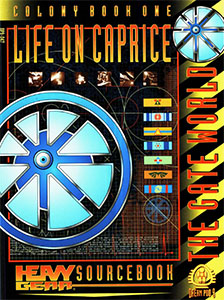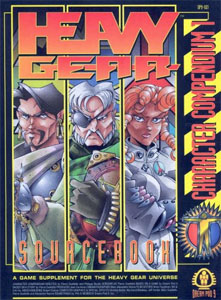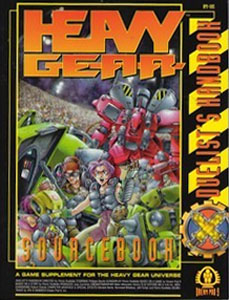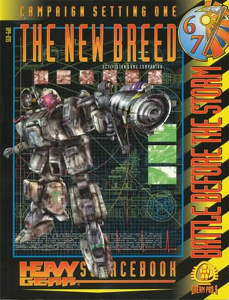 Tagline: A truly unique product. This is the crest of a new wave. How many sourcebooks can you say that about?
Tagline: A truly unique product. This is the crest of a new wave. How many sourcebooks can you say that about?
The New Breed: Battle Before the Storm, Campaign Setting One for the Heavy Gear game, is something which you very rarely see in this industry or anywhere else: Something completely original.
(The pedants among you – you know who you are – are already saying to themselves: “But nothing’s completely original!” Yes, you are right. This book is still made of paper. Ink was still used in the printing. The rest of us safely conclude that things can still be completely original, even if you are still breathing air while partaking of them.)
I say this for several reasons. First, The New Breed was the first of Dream Pod’s campaign supplements. Any serious line of roleplaying product always, at some point, begins publishing adventure supplements of one variety or another (this dates all the way back to the original D&D modules as everyone well knows). Like so many other things the Pod has done, however, their campaign supplements take the industry to a whole new level and challenge everyone else to follow suit or get out of the game.
Second, this product demonstrates how to combine a tactical and a roleplaying campaign into one; plus it is designed in a modular fashion such that either one can be removed and played without the other.
Third, this isn’t actually a single campaign, but two. One of them puts the players on the northern landship Vigilance; the other puts them on the southern landship Draco. Although this may have been done before outside of my knowledge, I’ve never seen a roleplaying product be daring enough to assume that the players could take part on both sides of a conflict. Of course this is merely endemic of the overriding brilliancy of Heavy Gear’s world design: The setting is real, not manufactured. The players can play both sides of a conflict because both sides of the conflict truly exist – one side is not merely there to provide an imaginary foil for the other.
Fourth, this product is not just a supplement for roleplaying or tactical players, but also a companion volume to the Heavy Gear computer game designed by Activision. Throughout the design process of the computer game Dream Pod 9’s creative staff and the creative staff at Activision collaborated extensively to incorporate the setting into the game and the game into the setting. The New Breed serves in places not only as a behind-the-scenes peek at the computer game, but also provides a depth to the characters and the situations found in the game which would otherwise be impossible. Don’t mistake me with this at all – this is not a cheat guide or a self-congratulatory tract: It is a valuable product in its own right. Think of it like this: Typically a really excellent campaign supplement provides a plethora of background material and the outlines of an adventure, built upon this background material, which you then use to create your own particular version of the story with your players. In the case of The New Breed you are shown the plethora of background material which was then used to create the computer game, and then given the outlines of two series of adventures which serve as preludes to the computer game. The New Breed can exist entirely separately from the computer game and the computer game can exist entirely separately from The New Breed; but the two complement each other in an amazing fashion (with events in one suggesting and leading to events in the other, for example). Only a handful of other companies in this industry (TSR/WOTC, FASA, SJG, and White Wolf) have ever had the opportunity to create a product such as this – none of them have.
The Heavy Gear campaign settings hold a particularly dear place in my heart. The second campaign setting, The Paxton Gambit, was one of the first supplements to the game I ever read. It was to me, at the time, such an amazing and original product that I immediately felt compelled to write a review of it and share its wonders with the rest of the world. It was the first review I ever wrote for an RPG (I did a stint of reviewing computer games when I was much younger), and it can be found elsewhere on RPGNet the Alexandrian.
I like to think, however, that I’ve improved as a reviewer since then. The New Breed is a much different product from The Paxton Gambit (the latter wasn’t complementing a computer game and was designed strictly for roleplaying use, for example) and also cruder in some ways, but I would like to take this opportunity to discuss the general way in which the roleplaying campaigns in both are set up. The tools which Dream Pod 9 used in creating these products are unique and are, arguably, the greatest strength of these two books.
First, the campaign is broken up into scenarios. These function like the episodes of a television drama – thematically united series of events with a beginning, middle, and end which, nonetheless, make up a part of a greater whole. In The Paxton Gambit each scenario was clearly designed to comprise a single session of gameplay. Things are a little less clear-cut in The New Breed, but the amount of space given to each scenario is also smaller in The New Breed and things are slightly more broken up due to the tactical components (which I will discuss in a moment) – this is one of the reasons why I call the effort in The New Breed “cruder” than that found The Paxton Gambit.
Where this format really shines, however, is in the second step – where each scenario is broken down into important milestones. This is an important change over the way published adventures have previously been presented in this industry. Ever since the first modules for D&D were produced, adventure supplements have generally attempted to be as complete as possible. The early D&D attempts did this through their location-by-number designs (so that the GM knew what would happen everywhere the PCs went); White Wolf does it by detailing the actions of every scene. The problem with these approaches (and others) is that it is extremely easy for the adventure to become railroaded – players have a difficult time feeling that their characters have any impact on the outcome since not only the outcome, but the course they would take to get there, has been charted out in advance. To counteract that was almost impossible. Either you had to generalize the adventure down to a basic premise (making it less useful for the GM) or you had to accurately predict possible actions PCs would take even though you knew next to nothing about the PCs themselves (as everyone knows, players have an uncanny knack for finding unexpected courses of actions even when you’ve known them for years) or you had to chart out as many possible courses of action as possible (which meant that your adventure was either short and simple or that your product was of mammoth proportions).
Dream Pod 9 has apparently found a third way, so to speak. Instead of detailing the exact course an adventure must take, they have specified only the important “milestones” which must be passed along the way. These milestones provide a general map which can then be easily particularized to the needs of the individual GM almost on the fly. Because only the broad outlines have been provided the characters are not railroaded. Because it is the essential elements which are discussed the GM is not left on his own. The perfect balance between two unsavory and difficult extremes.
The other strength of the milestone system is that it extremely flexible. The set of milestones presented give a complete adventure, but in many cases these milestones can be switched around with ease. Plus additional scenes and situations can be inserted between the existing milestones with ease. Dream Pod 9, again, takes advantage of this by giving several possible “complications” and “continuing hooks” which can be used to modify the basic package which is presented.
Finally each scenario is rounded out with the statistics for the NPCs found in it. These stats take advantage of the archetypes found in the Heavy Gear Rulebook and the campaign book itself, noting only the modifications necessary to personalize them to the particular character. This method means that the NPC stat section only takes up about an inch of space on the page (the personalities of the NPCs are discussed in the text of the milestones).
The end result? A modularized set of adventures which are easily customizable without requiring massive commitment from the GM – you get most of the advantages of designing your own adventures, while still gaining the primary strengths of a published scenario (less time and work spent on preparation). Plus, since the format for these adventures takes up less space than those designed in the “completist” tradition, you end up with a dozen or so scenarios – more than enough to make the book truly a campaign resource.
And that’s only half of the book. The other half is a sourcebook for the location the adventures are set. As it has been noted before by myself and others: Dream Pod 9 may have a reputation for slim, expensive books… that’s only because they cram about ten times as much material into the same amount of space.
All of that being said, I did mention earlier that I consider The New Breed to be a cruder effort than The Paxton Gambit. This is to be expected considering that The Paxton Gambit is the later of the two products, but allow me to take a moment to clarify those comments further so that there is no misunderstanding. The New Breed is an exceptional, powerful product which – in my opinion – revolutionizes the way in which adventures will be presented in the future of the roleplaying industry. It introduces a plethora of tools which are extremely powerful. It also fumbles the ball a bit in a couple of places, which is fairly typical for any product which breaks new ground. The Paxton Gambit takes these tools, polishes them up, and uses them to their full effectiveness. The New Breed, for example, has some milestones and scenarios which blend into each other, its continuing hooks are listed at the beginning of each campaign, and NPC stats are listed with every scenario they appear in. The Paxton Gambit has a much firmer grasp of how to define each scenario and how to break each scenario down into milestones; it also moves the continuing hooks so that they supplement each scenario, rather than supplementing the campaign as a whole; and, finally, NPC stats appear only once so that there is less sense of repetition. It’s a subtle set of differences, but an impressive improvement from one product to the next.
Of course the important thing in any set of adventures is the quality of the stories being told. Whatever the mechanical difficulties, the story told in The New Breed is nothing to be ashamed of. As usual Dream Pod 9 has excelled. The fact that I am getting hung up on analyzing minor technical improvements and differences between their product only demonstrates the general excellence of those products.
The other difference between The New Breed and The Paxton Gambit campaigns, however, is the inclusion of tactical scenarios in the former. These tactical scenarios are designed to be playable in tangent with the roleplaying scenarios, or they can be spun off by themselves (just as the roleplaying elements of the campaign can be). These scenarios appear to be generally sound and look like a lot of fun, although I have not had a chance to playtest them.
All of this now leads me to discuss the problems with the campaigns, which is the primary reason why this book garnered a lower substance score than is typical for a Dream Pod 9 product. First, both roleplaying campaigns suffer severely because they fall prey to that classic flaw of adventure design: All the interesting stuff is happening to the NPCs and the only thing the players get to do is watch it happen. It is easy to understand how this happened. The scenarios are designed to be preludes to the computer game. The Pod didn’t want to force players into playing pre-generated characters, but all of the interesting stuff in such a prelude is going to happen to the characters who show up in the later story – i.e., the NPCs. The fix to this is simple: Either have your players play the NPCs, or adapt the primary story so that the player-designed characters become the focus of the described events. Either is fairly easy, but should have been unnecessary.
More serious, however, are what I see as fundamental flaws in the southern campaign set onboard the Draco. It is difficult to quantify them specifically in a short review such as this, but I’ll take a general stab at it. First, the storyline is fairly disjoint – acting as a series of episodic problems which are only loosely connected. Plus actions which are initiated are never followed up. In the northern campaign PCs are distanced from the action, but this problem is aggravated to new heights in the southern campaign – in one case an entire landship is nearly destroyed while the PCs are in town spending an entire scenario buying supplies. Finally, the tactical scenarios are almost completely disconnected form
It is difficult to quantify them specifically in a short review such as this, but suffice it to say that the storyline is fairly disjoint. Whereas the PCs are minorly distanced from the action in the northern campaign this problem is further aggravated in the southern campaign – in one case an entire landship is nearly destroyed while the PCs are in town spending an entire scenario buying supplies. Some of the tactical scenarios are almost completely disconnected from the actions described in the roleplaying campaign. Finally, major plot points which are raised and discussed early in the campaign are never followed through on in the later part of the campaign.
The campaigns are not the only strength of The New Breed however. Both the Draco and the Vigilance (the two landships) are given an indepth treatment, as are their important crewmembers. They provide a vivid resource for any GM thinking about running a Heavy Gear campaign set onboard a landship and display the typical technical accuracy and adeptness which Dream Pod 9 has demonstrated in the past. The technology in Heavy Gear is not composed merely of pretty pictures, but of hard military and scientific knowledge.
Finally the book is fleshed with the stuff which directly complements the computer game – a few brief words from some of its designers; a full color section providing a look at design sketches; an overview of the major Gear designs intended to serve as an introduction for those coming to the roleplaying game from the computer game (but also useful for anybody); and some other miscellaneous stuff.
So let’s wrap it up. For your twenty-five bucks you get a fairly thick Heavy Gear supplement with a full color section; two complete campaigns presented in a revolutionary style; more background material than you would typically get in any other company’s dedicated sourcebooks; a prelude look at the characters and settings which make up the Heavy Gear computer game; a look behind the scenes of that same computer game; and a host of other miscellaneous resources. It’s like an all-the-stuff-you-can-eat special for a roleplaying game! Whatever flaws might exist in this product are quickly overwhelmed by the pure amount of high-quality material which is present.
Style: 5
Substance: 4
Author: Jean Carrieres, Tyler Millson-Tyler, Marc Alexandre-Vezina
Company/Publisher: Dream Pod 9
Cost: $24.95
Page Count: 136
ISBN: 1-896776-20-5
Originally Posted: 1999/04/13
I actually ended up writing one of these campaign supplements for Heavy Gear. In fact, it was my first professional assignment in the RPG industry. Unfortunately, it was never published because these supplements drastically underperformed in the marketplace. (Some of the material was rewritten to become part of Storm on the Horizon.)
My assessment of these books would probably be quite different today. The structures are heavily based around linear plots and the milestone approach — while allowing you to pack a lot of territory into a very small page count — nevertheless eschews the type of gritty prep work (like stat blocks) that I think are most valuable in terms of saving time for the busy GM. Nevertheless, there’s a lot of good stuff to be found in them. And I consider them really important antecedents to the modern era of Adventure Paths and the like.
For an explanation of where these reviews came from and why you can no longer find them at RPGNet, click here.
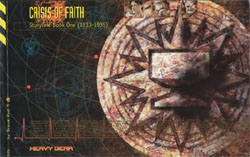 To paraphrase somebody famous, there are two ways to handle a meta-story: The right way and the wrong way.
To paraphrase somebody famous, there are two ways to handle a meta-story: The right way and the wrong way.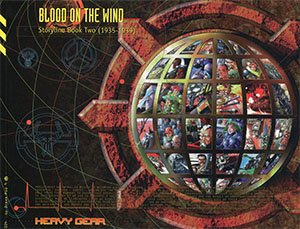 This second key leads directly to the concept of the Storyline Book: Instead of spreading the development of the meta-story across a myriad array of unrelated products, Dream Pod 9 has instead concentrated the story into this single set of books. The information to be found here, of course, is supported in other products – but it’s supported in the same way that other game lines support their standard world information. In other words, if you want more information about, for example, the Black Talon program you’d pick up the Black Talon Field Guide. But if you weren’t interested in having detailed coverage of the Talons, then the information found in Return to Cat’s Eye would be more than sufficient to let you know what the major developments with the Talons are. This gives you the ability to follow the meta-story of Heavy Gear without having to buy every Heavy Gear product that the Pod produces (regardless of whether or not you actually want the information found in that product). The Pod will make you want to own the books, but will never require you to own anything more than a tightly controlled set of core resources.
This second key leads directly to the concept of the Storyline Book: Instead of spreading the development of the meta-story across a myriad array of unrelated products, Dream Pod 9 has instead concentrated the story into this single set of books. The information to be found here, of course, is supported in other products – but it’s supported in the same way that other game lines support their standard world information. In other words, if you want more information about, for example, the Black Talon program you’d pick up the Black Talon Field Guide. But if you weren’t interested in having detailed coverage of the Talons, then the information found in Return to Cat’s Eye would be more than sufficient to let you know what the major developments with the Talons are. This gives you the ability to follow the meta-story of Heavy Gear without having to buy every Heavy Gear product that the Pod produces (regardless of whether or not you actually want the information found in that product). The Pod will make you want to own the books, but will never require you to own anything more than a tightly controlled set of core resources.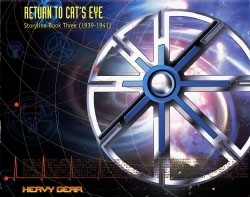 If the last six pages of Crisis of Faith hit you with the power of a sledgehammer, then the first two pages of Blood on the Wind will send you reeling across the room… and the thrills are just beginning: The world goes to hell and Dream Pod 9 is taking you along for the ride. If you thought the beginning was surprising, just wait until you see the end: A grand mystery is left unsolved and a new crisis looms on the horizon.
If the last six pages of Crisis of Faith hit you with the power of a sledgehammer, then the first two pages of Blood on the Wind will send you reeling across the room… and the thrills are just beginning: The world goes to hell and Dream Pod 9 is taking you along for the ride. If you thought the beginning was surprising, just wait until you see the end: A grand mystery is left unsolved and a new crisis looms on the horizon.
